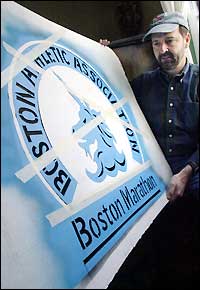|
2002 BOSTON MARATHON
Knowing how to draw the line
Since 1982, Jacques LeDuc has had designs on Marathon start By Eun Lee Koh, Globe Staff Correspondent, 3/24/2002
For 20 years, he has been the man who painted the starting line for the Boston Marathon at 1 Ash Street in Hopkinton. At times, he is foiled by vandals, other times by the weather, but without fail, he turns up several days before the Marathon, armed with hand-cut stencils and spray cans to lay down the 5-foot-wide line that lets runners know where the race begins. "Yeah, 16,000 people stomp all over your artwork; it's one of those times where it's OK, " LeDuc said with a chuckle. "I don't say it out loud. I don't go out there, see the starting line, and think to myself, `Hey, that's mine.' But I guess it is." The starting line follows a standard pattern each year - a broad line stretching from one end of Ash Street to the other with the logo of the Boston Athletic Assocation, the group that oversees the Marathon. But to give himself and the runners variety each year, LeDuc, 51, makes slight adjustments to the starting line each time he goes to his drawing board. He subtly varies the type of font or the size of the association's logo. He even destroys his used stencils after each race, so he can start fresh with a new design the following year. "It's tempting to use the same ones over again, especially if they were intricate," LeDuc said. "But in an effort to force myself to change, I get rid of them. I just cut them up and put them in the recyling bin." This year, both the starting line and the logo will have a distinctly patriotic feel, LeDuc said. Last month, the Boston Athletic Association unveiled its new Marathon logo, which was altered to link Patriots Day with the race. (The Marathon is always run on the Monday on which Patriots Day is celebrated, which this year is April 15.) The new logo keeps the association's unicorn centered between two American flags under a blue Patriots Day banner, and the traditional gold and blue colors have been swapped for red, white, and blue. "He's been doing this for, like, a hundred years," said Dave MacGillvray, the director of the Boston Marathon. "He's as much a part of the Marathon as the runners are." By this time of year, LeDuc usually stocks up on gallons of gold and blue road paint and spray cans, but now he has red, white, and blue paints stored in his house. In the next several weeks, he predicts he will spend about 20 to 30 hours, drawing the design onto cardboard and cutting it out by hand. About five days before the Marathon, weather permitting, he will head to Ash Street with his usual assistants, his two daughters, who have been helping him paint the starting line since they were toddlers. "I'm hoping I can pass the torch to my children," said LeDuc of his daughters, who are now 17 and 18. "It's been an outing for us ever since I started. I have pictures of them sitting on the curb when they were little, watching me paint." For several years during the 1990s, he also painted the finish line in Boston, but after years of navigating confusing one-way streets in the city, he gave up and decided to focus solely on painting the starting line. Painting the lines usually was an all-afternoon affair, and the weather often didn't cooperate. To paint both the start and finish lines, he would need two good days, but sometimes he wasn't that lucky. "There was one time when it snowed like crazy a week before the race," LeDuc said. "I was afraid the line wasn't going to get painted, but luckily the snow melted, and it turned out OK." As a child, LeDuc, who was born and raised in Hopkinton, gathered with his family at the town center each April to watch the start of the Boston Marathon. But decades later, in 1981, a friend of LeDuc's, aware of his penchant for stenciling and drawing, unwittingly volunteered him for the job of making a sign to commemorate the legendary runner Johnny Kelley, who was running his 50th Boston Marathon that year. That was the first year that LeDuc worked for the Boston Marathon. The following year, he volunteered to paint the starting line. When he first started, he incorporated the colors of the Hopkinton schools, green and white, but in 1996, for the 100th anniversary of the Marathon, he changed the colors to gold and blue, to match the Boston Athletic Association logo. That year, he also painted the starting line so that it would be 100 inches wide. "Way back then, when I was a kid, it was a just a white line," he said. "Everyone knew it was a starting line. It wasn't all that interesting, but I never really gave it much thought. It was a line, people got behind it, and that's all there was. It's different now."
|
|||||
 Jacques Leduc has designed and stenciled the start and finish lines for the Boston Marathon since 1981. (Globe Staff Photo / Mark Wilson)
Jacques Leduc has designed and stenciled the start and finish lines for the Boston Marathon since 1981. (Globe Staff Photo / Mark Wilson)
 OPKINTON -- Jacques LeDuc has competed in the Boston Marathon for the past five years
and is known more for his start than his finish. But without LeDuc, the other
runners wouldn't know where to begin.
OPKINTON -- Jacques LeDuc has competed in the Boston Marathon for the past five years
and is known more for his start than his finish. But without LeDuc, the other
runners wouldn't know where to begin.